
Chapter 6
Indian Removal Policy
-- White settlers believed that Indians stood in the way of their progress
-- 1820's Isaac McCoy, Baptist minister, believed that Indians would like to live in Kansas
presented this idea to Sec. Of War Calhoun
-- William Clark, Superintendent of Indian Affairs negotiated treaties (agreements) with the Kansa and Osage Indians
to insure move of Indians Congress passes the Indian Removal Act of 1830
promised the land in Oklahoma for "as long as the grass grows and the rivers run"
which was until 1906
- Trail of tears -- forced marches to insure move of Indians
- Five civilized tribes
- Choctaw, Chickasaw, Creek, Cherokee, Seminole
- Cherokee adopt republican form of gov’t.

John Ross Cherokee leader
1/8 Cherokee
- Have written language (Sequoya)
Chief Justice John Marshall rule in favor of the Indians
President Andrew Jackson " He’s made his decision, now let’s see him enforce it"
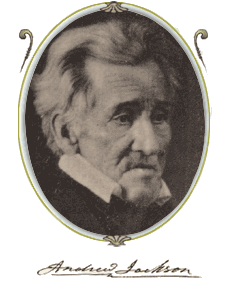
First group of 3000 began in summer of 1838 by boat up the Tenn. river
14,000 waited in prison camps and traveled during the winter of 1838-1839 forced there by 7000 U.S. Troops
one third to one fourth died on the trail 3000 to 4000 deaths
Conducted using U.S. Troops
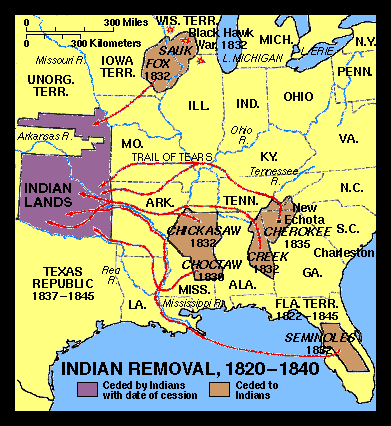
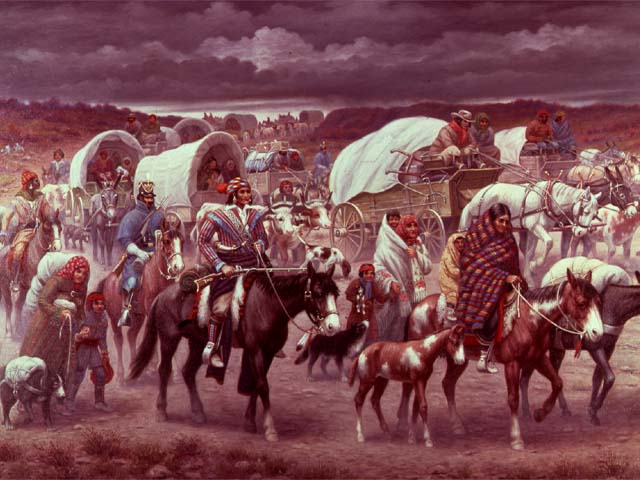
70,000 Indians give up their homes
Cherokee Indians of Georgia
Shawnee and Delaware Indians of Missouri
-- Also Ottawa, Sac, Fox, Kickapoo, Miami, New York, and Quapaw

-- Indians did not like the climate or environment of Kansas
Settlers and Governmental officials cheated the Indians out of blankets, food, clothing, and shelter
Resale to whites or pocket money
-- Indians fought among themselves and took advantage of each other
Missionaries from different tribes tried to "civilize" the Indians
-- teach them the white mans way and to abandon their own way of life
Osage Mission tried to teach Christianity to the Indians
"Mission Neosho" the first Indian mission in Kansas
even before Indian Removal Act 1824
1831 -- Shawnee Baptist Mission was started by Johnston Lykins
Jotham Meeker brought the first printing press to Kansas
Prints the first book in Kansas
Ottawa Indian Laws
Ottawa University develop later at mission
-- Started Shawnee Sun (Siwinowe Kesibwi) a newspaper
-- moved to Ottawa Indians near
Franklin County
Printing hymnals, scriptures, and newspaper
1832 -- Shawnee Methodist Mission in Wyandotte County (1839) moved to Johnson County
Run by Thomas Johnson until it closed in 1862
Johnson County Organized in 1855. County seat, Olathe. Named for Rev. Thomas Johnson, a Methodist minister, who in 1829 established a mission among the Shawnee Indians, about eight miles southwest of Kansas City. Mr. Johnson took the pro-slavery side of politics, and was a member of the first territorial council. He was, when the war came on, a faithful union man. He then lived in Missouri, and become obnoxious to the bushwhackers, they sacked his house, and he was shot and killed, in January 1865.
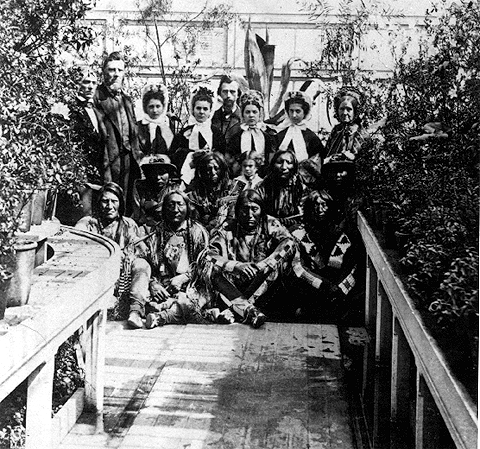
Other missions started by
-- Society of Friends (Quakers) among the Shawnee Indians;
-- Presbyterian mission for the Iowa, Sac, and Fox Indians in Doniphan County and among the Kickapoo Indians
-- Protestant Missionary the Moravians (United Brethren) among the Munsee Indians near Wyandotte
Potawatomi Baptist Manual Labor School, just south of the Kansas River near present-day Topeka
Federal Government would pay $50 to $75 per student enrolled at the missions
Some of the missions were moderately successful in developing friendships with the Indians
However the Indians did not want their children to learn the "white mans" way of life
Staunch resistance
Indians tribes Removed from Kansas
As the white man moved west the Indians were threatened with loosing their land
Whites claim the Indians were not making economic use of their lands in Kansas
1854 Tribes started giving up their land to move on to other land in Indian Territory
By 1870 most of the tribes had been removed to Indian Territory (Oklahoma) complete removal was accomplished by 1881
Indian Wars In Kansas
With the settlers and railroads moving west they created problems for the Indians
Whites were crossing Indian lands, hunting and taking from Indian resources
1864 -- Colonel John M. Chivington
"Damn any man who sympathizes with Indians," he said. "Kill and scalp all, big and little; nits make lice." He ordered the attack.
his troops massacred a camp of Cheyenne and Arapaho Indians (Sand Creek Massacre) eastern Colorado
Chief Black Kettle and
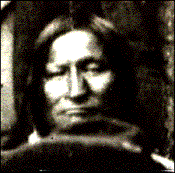
Chief White Antelope
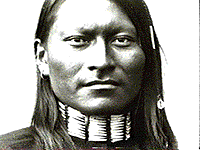
flew an American flag and a white flag and thought they were under military protection
750 troops killed 300 Indians
White Antelope's scrotum had been cut off, later to be used as a tobacco pouch.
225 were women and children
bodies were mutilated
10 soldiers died
-- Indians in Kansas retaliated by attacking along the Smoky Hill and Santa Fe Trails and the Solomon and Saline River Valleys
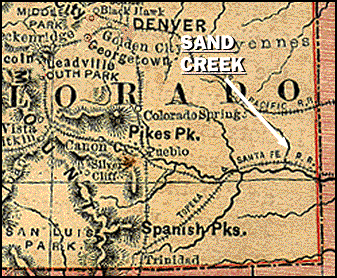
Several attempts at Peace
Maj. Edward Wynkoop – Peace commissioner
Little Arkansas Treaty- Indians accept reservations south of the Arkansas River
Agree to leave white travelers alone
In return, Indians receive Annuities
Payments from the government
Cash, homes, farms, agricultural implements, food, blankets, and clothing
Peace short lived
Government building more Forts to protect white travelers -- Dodge, Hays, and Wallace
1867 -- Major campaign launched against the Indians
Lead by Major Winfield Scott Hancock
also fighting Lt. Col. George A. Custer and the Seventh Cavalry
(scout for troops was James Butler Hickok "Wild Bill")
surprise attack did not work
1400 troops were supposed to scare the Indians.
Peace attempt at Medicine Lodge 1867
still some fighting
Indians complain whites taking land promised to the Indian
Sand Creek only two years ago
Again agreed to move to reservations
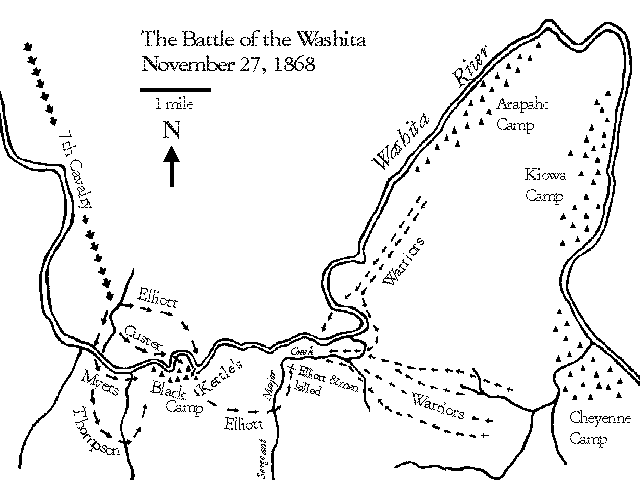



Buffalo face mass extermination after Great hunts by rich and visiting royalty and railroad
Last major problems in 1878 when a band of northern Cheyenne led by Dull Knife and Little Wolf left their reservation to travel to their aboriginal homeland in Montana
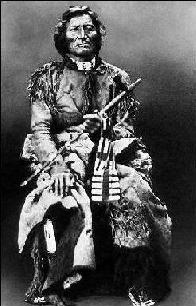

Dull Knife Little Wolf
several battles near Scott City
Battle Canyon
Made it across Kansas
Had to kill several settlers and take their horses
captured and placed on reservations
Indians today in Kansas
1990 census statistics 2,477,574 persons
17,800 Indians in Kansas
2000 census statistics 2,688,418 persons
about 27,000
Four reservations in Kansas
Kickapoo near Brown County
Potawattomi in Jackson County
Iowa in Brown and Doniphan County
Sac and Fox in Brown County